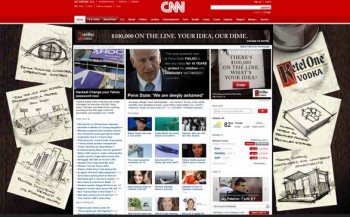
See above a screenshot of CNN's obtrusive advertising. Where's the news? (Credit: CNN, screenshot)
Commentary
CNN recently used much of the front page of its website to advertise Ketel One vodka. The advertisement went live July 12, 2012, and framed its homepage taking up more of the screen than the news. It was a flash style frame that stayed on your screen even when you scrolled down so you could not escape it.
Covering the whole screen with advertising images that overwhelm the text is off-putting for readers. They may remember the vodka but feel invaded. When an advertisement dominates a news website it gives the impression that news reporting is secondary to advertising and making money.
What’s next? Covering the whole broadcaster with ads like in NASCAR?
.JPG)
(Photo Illustration by London Shearer Allen.)
It was obtrusive enough to draw comments from CNN readers around the internet.
One tweeter, Amy Hoover, observed:
“Wow, #CNN totally sold out to Ketel One – I can barely find the headlines this morning. That’s what I get for still going there…“
Michael Durwin tweeted “So CNN gave Ketel One a site takeover?” and Christine Cavalier responded –
“the subtle message is we all need a shot or two before we even try to stomach CNN’s crappy reporting.”
(That is probably not the message they were going for.)
Other blog posts and discussions ranged from conspiracy theories to questioning its appropriateness. Navito Grande blogged:
“On one hand, I know we all need money but on the other hand – – it just didn’t seem like a site for news.”
CNN is usually more appropriate with its advertisement on the front page. They generally have one small advertisement at the top of the page and two or three even smaller advertisements at the bottom. So a full frame advertisement was a big and unwelcome change.

See above a typical CNN homepage screenshot.
It is commonly accepted that news media websites sell space to advertisers to help defray the costs and it is expected that advertising will increase in the coming years but with the news media the line needs to drawn somewhere. In an environment where consumers trust news media outlets less and less, it is all the more important for news outlets to maintain the apearance of not selling out.
Check out other iMediaEthics’ reports on similar advertising versus news situations including when the New York Times‘ created a fake version of its homepage to advertise Coca-Cola and the multiple times the Los Angeles Times has run advertising wrap-arounds in the style of its front page.






